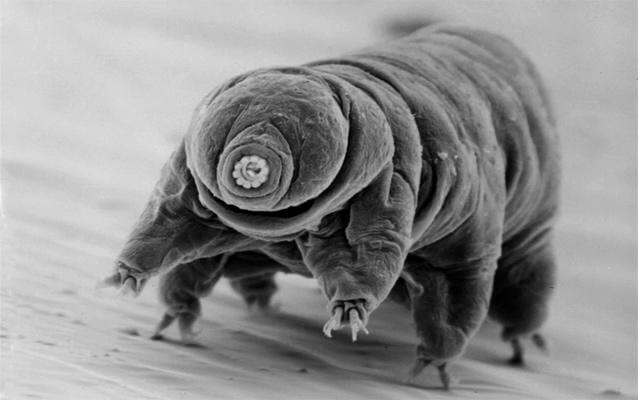Tardigrades
by Michael K. Schwartz
Broadcast 6.9 & 6.12.2020

Photo by Diane Nelson, National Park Service (public domain image).
Listen:
It’s early summer time in the Northern Rockies, a time for some bears to go into a hibernation-like state. Yes, you heard that right: bears that hibernate in the summer. What kind of bears are these, you might ask? They are the waterbears, also known as tardigrades.
A tardigrade is an invertebrate distantly related to the more common invertebrates such as spiders and snails. Yet, unlike spiders and snails, these animals are only 100 to 1000 microns long, equivalent in size to the width of a dime. But don’t let their small size fool you. These bears, like the grizzly or the black bear, have impressive claws. In fact, they have claws at the tips of all eight of their legs. Some of the claws are as long as an entire leg itself. The claws probably function to help capture their food, which varies from small bacteria to other small invertebrates, although in some species, they may be used to avoid predators such as amoeboid protozoans, other waterbears, and nematodes.
The first tardigrades were identified nearly 250 years ago in Europe by German zoologist Johann Goeze, who called them kleiner Wasserbär – or “little water bear.” North American waterbears, however, were not identified to science until 1873, when the naturalist Alpheus Packard found them in samples from New England. Subsequently, tardigrades have been found on every continent (even Antarctica) and at nearly all elevations. Yet they are most abundant at temperate latitudes, like here in Montana. In fact, they have been found from Quartz Creek in Glacier National Park to the top of Skalkaho Pass in the Sapphire Mountains. Here in Montana we have at least 20 species of tardigrades, from three distinct families.
So if tiny tardigrades are all around us, how can we see these fascinating invertebrates? Tardigrades are aquatic critters, found in both fresh and saltwater. They are mostly seen in the film of the water on mosses, lichens, liverworts or even flowers. They have even been seen in the water found between grains of sand on both fresh and saltwater beaches. The best way to see these invertebrates is to collect some damp moss, place it in a small bowl, and look under a good microscope.
One tardigrade biologist looked for these rugged invertebrates in a museum specimen of dried moss, which had been collected 120 years before. After submerging this moss in distilled water he searched and, believe it or not, found live tardigrades. They had simply gone into what is known as a “cryptobiotic state,” roughly similar to hibernation or torpor, awaiting damper conditions. This cryptobiotic state allowed the tardigrade, which can live in an active state for only a year, to survive for over a century. Cryptobiosis also allows the waterbear to survive not only dry conditions but temperatures as low as minus 270 degrees Celsius or as high as 151 degrees Celsius, and pressures as great as 1000 atmospheres. Pretty impressive for a creature with no circulatory or respiratory system.
So next time you are sitting around waiting for the rains to end (especially after a long dry spell), remember that another part of the animal world could be just coming back to life.
Every week since 1991, Field Notes has inquired about Montana’s natural history. Field Notes are written by naturalists, students, and listeners about the puzzle-tree bark, eagle talons, woolly aphids, and giant puffballs of Western, Central and Southwestern Montana and aired weekly on Montana Public Radio.
Click here to read and listen to more Field Notes. Field Notes is available as a podcast! Subscribe on iTunes, Google Play, or wherever you listen to podcasts.
Interested in writing a Field Note? Contact Allison De Jong, Field Notes editor, at adejong [at] montananaturalist [dot] org or 406.327.0405.
Want to learn more about our programs as well as fun natural history facts and seasonal phenology? Sign up for our e-newsletter! You can also become a member and get discounts on our programs as well as free reciprocal admission to 300+ science centers in North America!












